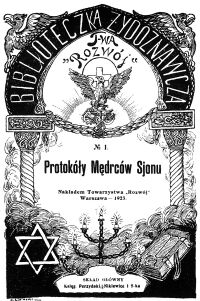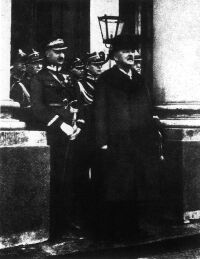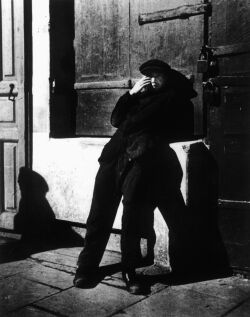





Protocols of the Elders of Zion, antisemitic brochure, describing alleged Jewish plan to achieve world domination. It was a hoax by tsarist secret police called Okhrana prepared at the turn of the century. Before the I World War it was of virtually no significance, but during the interwar period it became referred to by all the antisemitism propagJewish shop in Kraków's Kazimierz, 1937. The trade (over 40%) and in a lesser degree craft and services were main fields of the economic activities of the Jewish population in the Second Republic.andists.
Campaign against Jewish teachers. Efforts to eliminate the Jews not only from economic but also cultural life was another symptom of increasing wave of antisemitism.
Demonstration of the students of Lvov's Polytechnic demanding an introduction of "bench ghetto", 1937.
"Bench ghetto". Also universities became a scene of antisemitic excesses. Right-wing students more and more violently demanded execution of the "bench ghetto" regulations, dividing lecture hall into so called Aryan (Right) and Jewish (Left) side.
|

President Gabriel Narutowicz (1865-1922) just after taking the oath in Seym on 11th December 1922. He was elected due to votes of bloc of ethnic minorities, formed by the Jewish politician Icchak Grünbaum. The election resulted in outburst of antisemitic feelings in a substantial part of the Polish society. Brutal campaign against the President lead to the murder of him on 16th December 1922.
Street in Mińsk Mazowiecki after anti-Jewish incident, 8th June 1936. The radical parties declared the need for settlement of so called "Jewish issue" once for all and if necessary - by force. There reappeared pogroms of the Jews.
The sites of the most serious anti-Jewish incidents in Poland between 1935 and 1937. There were recorded about a hundred of them during this period of time.
Poster of the Camp of National Unity for the 1938 parliamentary elections; it exhortes to seclude and eventually expel the Jews from Poland. At the outbreak of the II World War among the Poles there was a high level of dislike towards their Jewish fellow citizens. It affected mutual relationships when the Nazis began to realize their plan of Holocaust.
|

Closed shop in Warsaw Jewish district, 1938.
Coexistence of the various nations in the independent Second Republic (65% of Poles, 16% of Ukrainians, 9,8% of Jews) was difficult. Due to the differences in languages, religions and customs the Jews and the Poles lived side by side but not together. Polish antisemitism was rooted both in politics and economy. It was a distinctive feature of the national parties programmes, particularly during the process of reconstruction of the Polish state. In the 1930s, and particularly after the death of Józef Piłsudski, it was reinforced by the government policy (e.g. its consent to economic boycott and the statute of 1936 restricting ritual slaughtering).
In the climate of propaganda and provocation there escalated a wave of assaults and tumults. The antisemitic slogans found their way even to the academic circles and the universities become a scene of antisemitic incidents inspired by the students connected with the national movements. Due to their pressure the authorities of some of the schools of the higher education schools introduced so called "bench ghettos" (separate benches for the Jewish students) and numerus clausus (limiting the number of Jewish students).
Economic boycott of the Jews, 1936. In the aftermath of the economic crisis, that afflicted both Christians and Jews, there increased the wave of economic antisemitism, with the consent of the government. Prime Minister F. Sławoj-Składkowski declared: "Economic struggle - by all means, but no harming".
|

